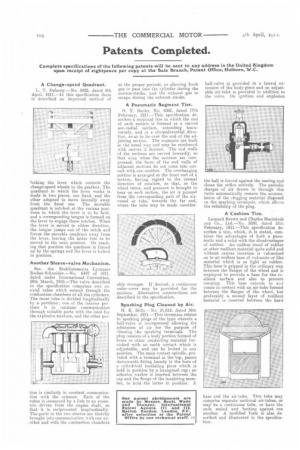Patents Completed.
Page 22

If you've noticed an error in this article please click here to report it so we can fix it.
Complete specifications of the following patents will be sent to any address in the United Kingdom upon receipt of eightpence per copy at the Sale Branch, Patent Office, Holborn, W.C.
A Change-speed Quadrant.
L. T. Delaney.—No. 8425, dated 4th April, 1911.—In this specification there is described an improved method of locking the lever which controls the change-speed wheels in the gearbox. The quadrant in which the lever works is made in two pieces, one fixed, and the other adapted to move laterally away from the fixed one. The movable quadrant is notched at the various positions in which the lever in to be held, and a corresponding tongue is formed on the lever to engage these notches. When the lever is moved in either direction, the tongue jumps out of the notch and forces the movable quadrant away from the lever, leaving the latter free to be moved to the next, position. On reaching that position the quadrant is forced up by the springs and the lever is locked in position.
Another Sleeve-valve Mechanism.
See. des Etablissements Lyonnais Rochet-Schneider.—No. 6447 of 1911, dated under International Convention, 29th March, 1910.—The valve described in the specification comprises two coaxial tubes which extend through the combustion-chambers of all the cylinders. The inner tube is divided longitudinally by a partition, one of the interior pmtions is in constant, communication through suitable ports with the inlet for the explosive mixture, and the other por tion is similarly in constant communication with the exhaust. Each of the tubes is connected by a link to an eccentric driven from the engine shaft, so that it is reciprocated longitudinally. The ports in the two sleeves are thereby brought into communication with one anether and with the combustion chambers at the proper periods, so allowing fresh gas to pass into the cylinder during the suction-stroke, and the exhaust gas to escape during the exhaust stroke.
A Pneumatic Segment Tire.
0. T. Banks, No. 4088, dated 17th February, 1911.—This specification describes a sectional tire in which the end of each section is formed as a curved non-radial surface, extending transversely, and in a circumferential direction, so as to lie over the end of the adjoining section. The segments are built in the usual way and may be reinforced with canvas if desired. The end walls of the sections are curved inwardly, so that even when the sections are compressed, the faces of the end walls of adjacent sections do not come into contact with one another. The overhanging portion is arranged at the front end of a section, having regard to the normal direction of rotation, so that, as the wheel turns, and pressure is brought to bear on each section, the air is pressed from the corresponding part of the airvessel or tube, towards the far end, where the tube may be made consider ably stronger. If desired, a continuous outer-cover may be provided for the sections. Alternative constructions are described in the specification.
Sparking Plug Cleaned by Air.
H. E. Mills.—No. 21,616, dated 30th September, 1911.—This invention relates to sparking plugs of the type wherein a hall-valve is incorporated allowing the admission of air for the purpose of cleaning the sparking terminals. The plug consists of a body portion formed of brass or other conducting material furnished with an earth contact which is adjustable, and can be locked in any position. The main contact spindle, provided with a terminal at the top, passes downwards fitting loosely in the bore of a cylindrical insulating piece which is held in position by a hexagonal cap ; an asbestos washer is inserted between the cap and the flange of the insulating member, to hold the latter in position. A
ball-valve is provided in a lateral extension of the body-piece and an adjustable air-inlet is provided in addition to the valve. On ignition and explosion the ball is forced against the seating and closes the orifice entirely. The periodic charges of air drawn in through this valve automatically remove the accumulation of the clogging material disposed on the sparking terminals, which affects the reliability of the plug.
A Cushion Tire.
Leonard Brown and Charles Macintosh wind Co., Ltd.—No. 3898, dated 16th February, 1911.—This specification describes a tire, which, it is stated, combines the advantages of both a pneumatic and a solid with the disadvantages of neither. An endless tread of rubber or other resilient, material quite solid and without canvas insertion is vulcanized on to an endless base of vulcanite or like material which is as light as rubber. This base is gripped in the ordinary way between the flanges of the wheel and is employed to provide a base for the resilient surface and also to prevent creeping. This base extends to and comes in contact with an air-tube formed between the flanges of the wheel, but preferably a second layer of resilient material is inserted between the hard
base and the air-tube. This tube may comprise separate sectional air-tubes, or may be a continuous tube, or have the ends sealed and butting against one another. A modified form is also described and illustrated in the specification.






















